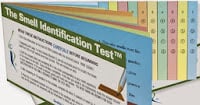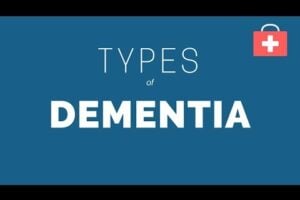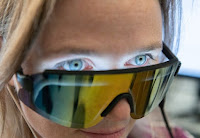Many people in the early stages of Alzheimer’s disease (AD) have subtle problems identifying odors, a finding that may appear insignificant in the face of looming cognitive decline. But two new studies — one from a team at Massachusetts General Hospital (MGH) and the other at Columbia University — suggest that odor identification tests could help in making an accurate diagnosis and may even precede the onset of memory problems. Researchers testing the efficacy of such biomarkers say that it could be done easily and inexpensively, and a positive test could pave the way for more expensive and extensive testing.
THE MASSACHUSETTS GENERAL HOSPITAL STUDY
Researchers at Massachusetts General Hospital (MGH) administered the 40-item University of Pennsylvania Smell Identification Test (UPSIT) — a scratch-and-sniff odor identification test with four multiple choices for each item, with a total score of zero to 40 — and a comprehensive battery of cognitive tests to 215 clinically normal people enrolled in the Harvard Aging Brain Study. This study, led by Reisa Sperling, MD, a professor of neurology at Harvard, examines subjects longitudinally by MRI scans, PET scans, and cognitive tests to identify and validate mechanisms and biomarkers that predict changes associated with Alzheimer’s disease.
Led by Mark Albers, MD, PhD, and Gad Marshall, MD, both assistant professors of neurology at Harvard, the research team compared the UPSIT scores and found that poorer scores were related to a smaller hippocampus, a thinner entorhinal cortex (EC) — particularly in the setting of elevations of amyloid-beta in the brain — and poor performance on memory tests. Age, gender, naming ability, and an estimation of cognitive reserve were factored into the analysis, which was done by Matthew E. Growdon, an MD/MPH candidate at Harvard, who presented the findings at the Alzheimer’s meeting.
The Massachusetts investigators evaluated the cross-sectional association between UPSIT and amyloid burden, bilateral hippocampal volume (HV), bilateral EC thickness, and interaction terms between Pittsburgh B (PiB) compound and HV and PiB and EC thickness. Further models investigated associations between olfaction and covariates with memory performance and EC thickness as dependent variables.
They found that poor scores on olfaction were significantly associated with decreased HV (p<0.001) and EC (p=0.003) and marginally associated with binary PiB status (p=0.06). In the multivariate model, thinner EC in PiB-positive individuals was significantly associated with worse olfaction (p=0.03). In unadjusted analyses, better olfaction was associated with better memory performance (p=0.03). In the multivariate model, lesser HV was associated with worse memory performance (p=0.004) but olfaction was not. In a multivariate model using EC as the dependent variable, thinner EC was associated with worse olfaction (p=0.02) and worse memory (p=0.04).
“Our findings suggest olfactory deficits may be present in the pre-clinical stages of Alzheimer’s. A decline in the sense of smell may be an early indicator of risk of Alzheimer’s in some individuals, a hypothesis that will be tested in longitudinal studies of this cohort, and hopefully others,” said Dr. Albers. He believes that olfaction may be vulnerable to Alzheimer’s because the olfactory bulb is directly connected to the entorhinal cortex, two brain regions that are damaged early in the course of the disease and exhibit robust plasticity in the adult brain, a common feature of vulnerability to AD pathology.
“The findings from olfactory tests may suggest a risk of developing Alzheimer’s, like narrowing of blood vessels in the brain identifies people that are at risk for stroke,” Dr. Albers added.
Additional studies are now being done to measure changes in the smell scores over time. If scores get lower over time, it may be possible to use this biomarker to track the benefits of a particular experimental drug.
About 90 percent of demented AD patients tested have shown deficits in olfaction, said Dr. Albers. The most robust olfactory finding to date related to risk of developing Alzheimer’s disease is odor identification.
THE COLUMBIA UNIVERSITY STUDY
In the second study on odor identification described as the conference, Davangere Devanand, MD, a professor of psychiatry at Columbia University Medical Center, and his colleagues conducted smell tests at three points in time in a longitudinal study of elderly people living in the community. Participants comprised a multiethnic sample of whites, African Americans, and Hispanics. They tested 1,037 non-demented elderly people with an average age of 80.7 years old and administered the UPSIT smell test in English and Spanish between 2004 and 2006 and again every two years thereafter. During the first follow-up period, 109 people transitioned to dementia and there were 270 deaths.
The scientists reported on the first follow-up on people tested between 2006 and 2008. Dr. Devanand said that lower odor identification scores on UPSIT were significantly associated with the transition to dementia and Alzheimer’s disease.
UPSIT remained a significant independent predictor of transition to dementia or AD (p<0.01) after controlling for demographic (age, sex, education), cognitive and functional measures, language of administration, and apolipoprotein E genotype.
For each point that a person scored lower on the UPSIT, the risk of Alzheimer’s increased by about 10 percent. Furthermore, lower baseline UPSIT scores were significantly associated with cognitive decline in participants without baseline cognitive impairment. Early on, the odor identification test was a stronger predictor of future memory impairments than measures of verbal memory.
“Odor identification deficits were associated with the transition to dementia and Alzheimer’s disease,” said Dr. Devanand. “We have also showed that people with MCI and odor memory deficits are more likely to be diagnosed with Alzheimer’s at the next follow-up.”
It is not known from any of these studies how early in the course of an adult life one can pick up odor deficits linked to subsequent Alzheimer’s, he said. “It has potential as a screening tool, but that prediction by itself is not that strong. Other factors have to be accounted for.” This could be added to other assessments, Dr. Devanand added.
Scores on these tests are also affected by age and gender: Women do better on smell tests by about two points on the 40-item scale, while elderly people show their own age-related deficits in olfaction.
The Columbia University group is now conducting a study where they administer a smell test and then treat patients with mild cognitive impairment (MCI) or AD for one year. They are hoping that a repeat smell test at the end of the study can be used to predict which patients’ memory and cognitive symptoms improve on the medication. The investigators will be blind to the results of the olfactory testing. The early cholinergic deficit is seen throughout the brain, including the olfactory tract, Dr. Devanand said.
“We think of Alzheimer’s as a disease of memory for words and pictures, but maybe it is also memory for sensory information as well,” said Dr. Devanand. He also wants to begin studying middle-aged people.
EXPERTS COMMENT
Karen J. Cruickshanks, PhD, a professor of ophthalmology and visual sciences in the Population Health Sciences School of Medicine and Public Health at the University of Wisconsin, has also studied odor deficits in people with cognitive impairments. Ideally, she said, good screening tests have high sensitivity and high specificity so that the tests correctly detect people who actually have (or will have) cognitive impairment, and correctly identify people who do not.
“To determine if a test is useful clinically, one should weigh how well it performs versus the risks/benefits of missing a case or having a false positive,” she added. She is not sure whether using odor identification tests as a biomarker would help in the diagnosis of AD. “Our data suggest the short-term absolute risk is low but the long-term story is not known. It is possible in combination with other biomarkers or tests that it might help identify high-risk people but long-term population-based studies would be needed before recommending it for screening. It may be more useful in people in geriatrics or memory clinics with patients reporting early symptoms of cognitive changes. As the authors of the studies suggested, long-term follow-up studies are needed to assess this possibility.”
Richard L. Doty, PhD, a professor and director of the Smell and Taste Center at the Perelman School of Medicine at the University of Pennsylvania, developed the UPSIT smell test that is routinely used in these types of studies.
“These studies are very interesting but the limitation in the real world is that smell loss is also indicative of the early stages of some other neurological diseases, most notably Parkinson’s disease, so while smell testing is sensitive to AD, it is not specific to AD,” said Dr. Doty, who was not involved with these studies. “Nonetheless, it is an inexpensive and non-invasive way of tracking possible cognitive decline, which has already proved useful in diagnostic contexts.”
“Since olfactory testing may be an early marker for a range of neurodegenerative diseases, I would suspect that its use in combination with genetic analyses in the future will be very fruitful,” Dr. Doty added.
LISTEN UP: In a podcast, Mark Albers, MD, PhD, and Davangere Devanand, MD, discuss their new research showing olfactory deficits as a possible biomarker for Alzheimer’s disease. Listen to their conversation at http://bit.ly/podcasts-nt
SOURCE:
Neurology Today











